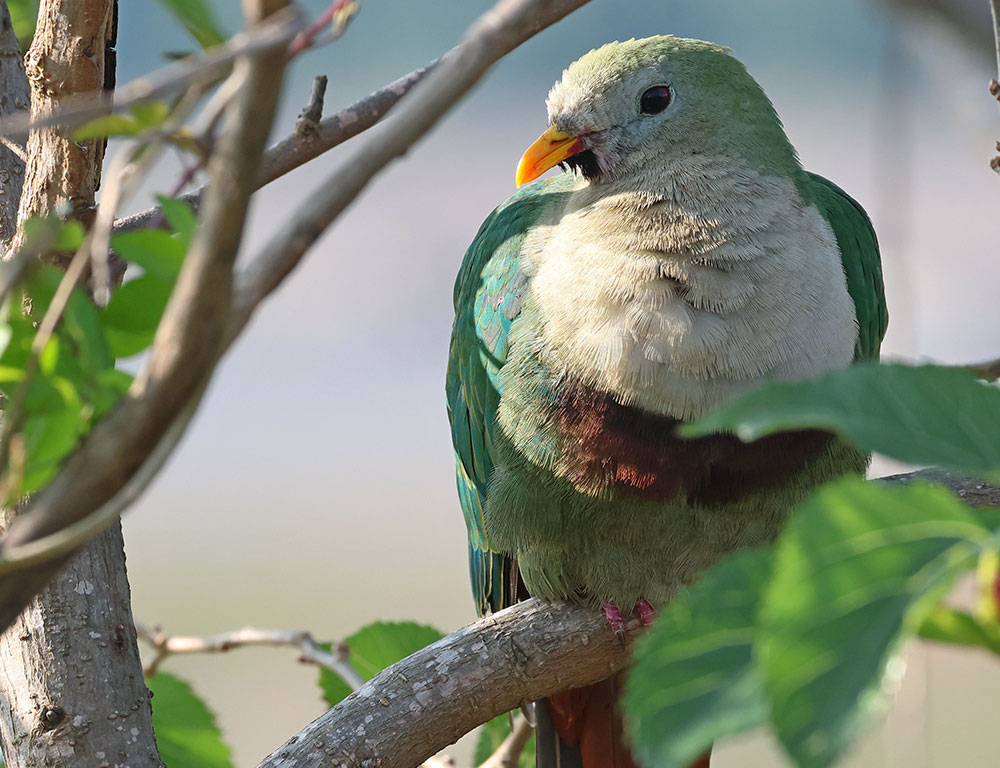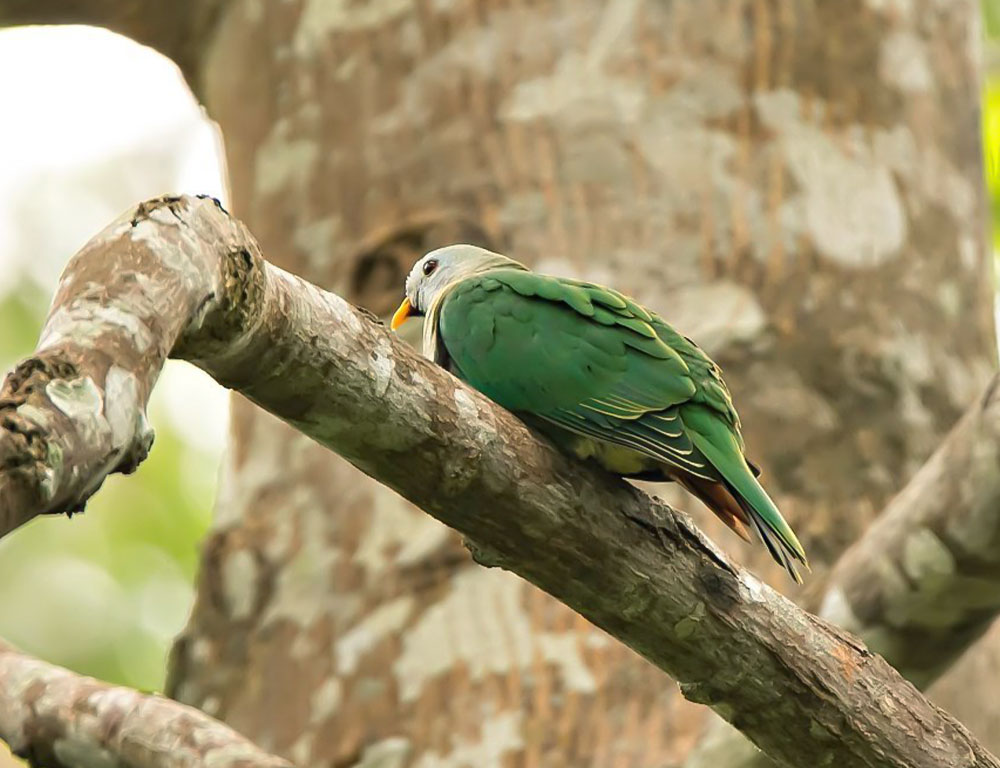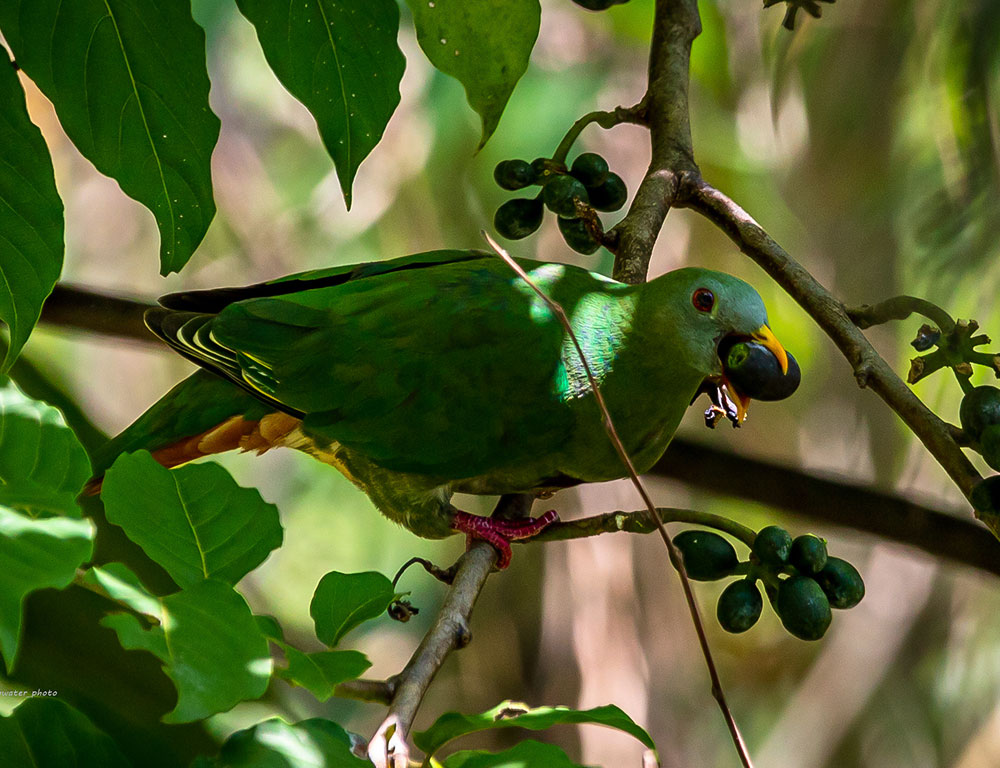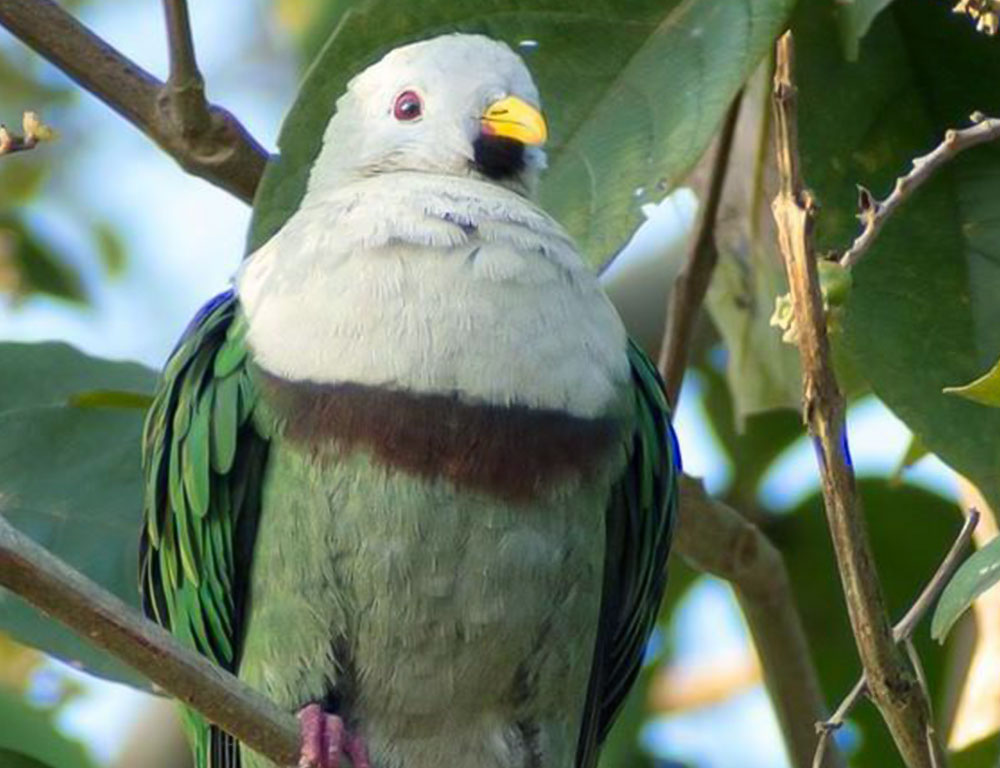Nestled within the lush canopies of Southeast Asia’s tropical forests resides a feathered marvel that captivates both the eye and the imagination: the Black-Chinned Fruit Dove.
This avian gem, with its serene demeanor and vibrant plumage of green, yellow, and purple, stands out amidst the verdant tapestry of its habitat.
Renowned for its peaceful nature, this dove’s penchant for fruits underscores its pivotal role as a seed disperser in forest ecosystems.
Delving deeper into the world of the Black-Chinned Fruit Dove reveals a tapestry of intriguing behaviors, from its habitat preferences to its vital contributions to biodiversity.
Join me on a journey to uncover the mysteries of these extraordinary birds as we explore their habitat, behavior, and ecological significance.

Physical Traits of the Black-Chinned Fruit Dove
The Black-Chinned Fruit Dove (Ptilinopus leclancheri) possesses distinctive physical characteristics that contribute to its unique appearance.
Here’s an overview of its physical traits:
Size
The Black-Chinned Fruit Dove is a relatively small bird, measuring approximately 9 to 10 inches (23 to 27 centimeters) in length from beak to tail.
Weight
On average, these doves weigh around 4 ounces (113 grams), making them lightweight compared to many other bird species.
Coloration
- Males: The males exhibit vibrant and striking coloration. They have predominantly green plumage covering their bodies, with the green often shimmering under sunlight.
Their chests and bellies are adorned with a rich purple hue, creating a visually stunning contrast. Notably, males also have a distinctive black chin, contrasting sharply against a white throat, giving them their name. - Females: While females share similarities in coloration with males, their plumage tends to be more subdued.
They have primarily green feathers, though not as vivid as males, with hints of gray on their chests. Like males, females also possess a black chin against a white throat. - Both Genders: A common feature among both genders is the presence of a black chin contrasting against a white throat, which adds to their overall aesthetic appeal.
Sexual Dimorphism
The Black-Chinned Fruit Dove exhibits sexual dimorphism, meaning that males and females display distinct differences in appearance.
This is particularly evident in their coloration, with males being more brightly colored and females having a more muted palette.
Other Features
- Beak: These doves typically have tiny, slender beaks adapted for feeding on fruits.
- Eyes: Their eyes are often dark or reddish-brown, providing a striking contrast against their colorful plumage.
- Wings and Tail: Their wings are rounded, facilitating agile flight through dense forest canopies, while their tails are relatively short.
Habitat and Distribution of the Black-Chinned Fruit Dove

The Black-Chinned Fruit Dove (Ptilinopus leclancheri) is primarily found in the lush tropical forests of Southeast Asia, particularly in Indonesia and Papua New Guinea.
Here’s a detailed overview of its habitat and distribution:
Geographic Range
- Indonesia: Black-Chinned Fruit Doves are distributed across various Indonesian islands, including Sulawesi and nearby regions. They can also be found in other parts of Indonesia with suitable forested habitats.
- Papua New Guinea: This species is prevalent in Papua New Guinea, which occupies forested areas across the island.
- Philippines: Black-Chinned Fruit Doves are also found in the Philippines, ranging from Luzon in the north to Mindanao in the south. They inhabit suitable forest habitats across the Philippine archipelago.
Preferred Habitat
- Tropical Rainforests: These doves primarily inhabit lowland tropical rainforests, where dense vegetation provides ample cover and diverse food sources.
- Mangrove Forests: Black-Chinned Fruit Doves may also be found in mangrove forests, particularly along coastal areas, where they can find suitable fruits and nesting sites.
- Altitude: While primarily found in lowland forests, Black-Chinned Fruit Doves have been observed at up to 1,500 meters above sea level. This suggests some degree of adaptability to different altitudinal zones within their range.
Human-Altered Landscapes
These doves have been reported in human-altered landscapes such as fruit orchards and plantations. The availability of fruit-bearing trees in these environments may attract Black-Chinned Fruit Doves, highlighting their adaptability to anthropogenic changes in their habitat.
Distribution within Range
While distributed across a broad geographic range, Black-Chinned Fruit Doves may be patchy within their habitat. Food availability, habitat quality, and human disturbance can influence their distribution within their range.
Behavior and Diet of the Black-Chinned Fruit Dove

The behavior and diet of the Black-Chinned Fruit Dove (Ptilinopus leclancheri) showcase its unique adaptations and social dynamics within its habitat.
Here’s a closer look at their feeding habits and breeding behavior:
Feeding Habits
- Frugivorous Diet: Black-Chinned Fruit Doves are primarily frugivores, meaning they primarily feed on fruits. Their diet includes a variety of fruits such as berries, figs, and small fruits from forest trees.
- Foraging Behavior: Unlike other dove species that may peck at fruits while perched, Black-Chinned Fruit Doves exhibit an interesting feeding behavior. They fly up and snatch fruits mid-air, demonstrating their agility and aerial prowess. Additionally, they may also consume fruits while perched.
- Dietary Supplements: While fruits comprise the bulk of their diet, these doves may also supplement their diet with insects or seeds, mainly when fruit availability is limited.
Breeding Behavior
- Courtship Displays: During the breeding season, male Black-Chinned Fruit Doves engage in elaborate courtship displays to attract females.
These displays may involve fluffing their feathers, bowing movements, and musical cooing calls to impress potential mates. - Pair Bonding: Once pairs are formed, male and female doves exhibit an intense bond through mutual preening and pair-feeding rituals. This bonding strengthens their relationship and cooperation during the breeding season.
- Nesting and Incubation: Females are primarily responsible for nest construction, using twigs collected by males.
The nests are typically small structures built in trees, where females lay a single egg. Both parents take turns incubating the egg, sharing the responsibility of ensuring its survival until hatching. This shared parental care highlights the cooperative breeding behavior of Black-Chinned Fruit Doves. - Nesting Structures: The nests built by Black-Chinned Fruit Doves are compact yet sturdy, representing an impressive feat of avian engineering. These nests provide a safe and secure environment for incubation and chick rearing.
Conservation Status of the Black-Chinned Fruit Dove

The conservation status of the Black-Chinned Fruit Dove (Ptilinopus leclancheri) is currently classified as “Least Concern” on the International Union for Conservation of Nature (IUCN) Red List.
However, despite this classification, significant conservation concerns and ongoing threats warrant attention.
Here’s a closer look at the conservation status and associated issues:
Threats
- Habitat Loss and Degradation: The primary threat to the Black-Chinned Fruit Dove stems from habitat loss and degradation due to deforestation and land conversion. Increasing human activities such as logging, agriculture, and infrastructure development pose significant risks to the bird’s natural habitat.
- Deforestation and Land Conversion: Deforestation accounts for a substantial portion of the threats these doves face, with approximately 50% attributed to deforestation and 30% to land conversion. The loss of lush forests, which serve as their home base, is detrimental to their survival.
- Hunting: While not as widespread as habitat loss, hunting remains a localized threat to some populations of Black-Chinned Fruit Doves. Hunting for food or capturing the pet trade can deplete local populations and disrupt breeding dynamics.
Conservation Efforts
- Protected Areas: Conservation organizations and governments are working to establish and manage protected areas, such as national parks and wildlife reserves, to safeguard critical habitats for the Black-Chinned Fruit Dove and other biodiversity.
- Regulations on Hunting: Stringent rules on hunting and trade are being imposed to mitigate the impact of hunting on blackned fruit Dove populations. Enforcement of hunting regulations is essential for reducing the threat of illegal hunting practices.
- Community Engagement: Raising awareness among local communities about the conservation status of the Black-Chinned Fruit Dove is crucial. Engaging local communities in conservation efforts and promoting sustainable land management practices can help mitigate threats and foster support for conservation initiatives.
- Habitat Restoration: Efforts to restore degraded habitats and conserve remaining forested areas are underway. Habitat restoration initiatives aim to create corridors for wildlife movement and increase habitat connectivity for Black-Chinned Fruit Dove populations.
Research and Monitoring
Continued research on the ecology, behavior, and population dynamics of the Black-Chinned Fruit Dove is essential for informing conservation strategies and assessing the effectiveness of management interventions.
Monitoring population trends and habitat changes can help identify emerging threats and guide conservation priorities.
FAQs
What is the typical lifespan of a Black-Chinned Fruit Dove?
The lifespan of a Black-Chinned Fruit Dove in the wild is estimated to be around 6 to 8 years.
How do Black-Chinned Fruit Doves communicate?
Black-Chinned Fruit Doves communicate through vocalizations, including cooing calls and other soft sounds, particularly during courtship and nesting periods.
Do Black-Chinned Fruit Doves migrate?
Black-Chinned Fruit Doves are generally sedentary birds, meaning they do not migrate long distances. However, they may undertake short-distance movements for food or suitable nesting sites.
Are Black-Chinned Fruit Doves social birds?
While they may form pairs during the breeding season and engage in mutual preening and pair-feeding rituals, Black-Chinned Fruit Doves are generally solitary or found in small groups while foraging.
Are Black-Chinned Fruit Doves kept as pets?
While they are not as commonly kept as pets as other bird species, some individuals may be kept in aviaries or as part of breeding programs in captivity. However, keeping wild birds as pets is generally discouraged due to conservation concerns.
Conclusion
The Black-Chinned Fruit Dove is a remarkable emblem of biodiversity in Southeast Asia and Oceania. Its vibrant plumage and distinctive black-chin feature add to its allure as a fruit-loving bird inhabiting lush tropical rainforests.
However, amidst its charm lies a sobering reality of habitat loss and population decline, primarily due to deforestation. As stewards of our planet, we must prioritize conservation efforts to safeguard this species from extinction.
By recognizing the importance of preserving biodiversity and each species’ intricate role in ecosystem balance, we honor the Black-Chinned Fruit Dove and countless other wildlife treasures.
Whether a seasoned ornithologist or nature enthusiast, let us cherish and protect these enchanting creatures for generations.